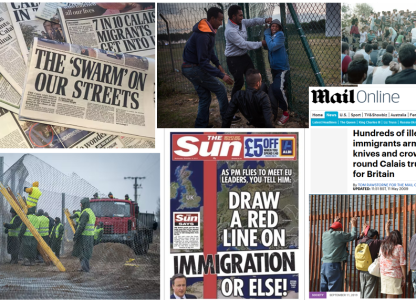“Imagine how it feels to be chased out of home. To have your grip ripped, loosened, from your fingertips something you so dearly held on to. Like a lover’s hand that slips when pulled away you are always reaching.”
(JJ Bola, 2018)
This is the start of the poem Refuge by a (former) refugee, JJ Bola, who fled with his family from the Democratic Republic of the Congo to the UK when he was six years old. In his poem he talks about forced flight, the perception of refugees and their integration as well as the concept of home – all from the authentic perspective of a (former) refugee [1].
When reading about refugees and the so called refugee crisis in the news media – offline or online –, the audience is often confronted with rather negative associations about refugees. The news media often use stereotypical representations by depicting them as vulnerable victims, as objects rather than human beings or as passive and helpless. Some news media outlets also associate refugees with being a “problem”, criminals or illegals which thus depicts them as threats to security or the local culture. Sometimes headlines already evoke feelings in the readers of fear or anger towards refugees. Sometimes, however, it is the pictures that evoke these kind of feelings in the audience – pictures representing refugees as “silent masses behind a fence” [2] or as undistinguishable individuals.

[3], [4], [5], [6], [7], [8], [9]
Of course not all the news media represent refugees in the same way, however, it is safe to say that there are stereotypical representations that do not necessarily shine a good light on refugees.
What these representations mostly have in common is that they do not give any real voice to the refugees, let alone agency. Refugee representations are often lacking humaneness – the authentic life stories with background and context are often missing much less the individuality of the refugee.
The question is, how refugee representation can be more authentic by giving refugees a voice of their own?
Self-representation is the keyword in this context. Lately, pictures of refugees taking selfies are increasingly used by news media – what is missing, however, is the actual selfie, the picture the refugee was taking. News media, however, usually only show pictures of the act of a selfie-taking refugee. This kind of representation is still in contrast to the actual selfie of the refugee – the actual selfie that falls in the category of self-representation.
Another question that consequently arises is, if self-representation of refugees is actually already taking place and if so in what way and on which channels?
In recent years, information and communication technologies (ICTs) have developed rapidly and more and more new technologies continue to emerge, helping industries to grow and develop increasingly. When looking at self-representation of refugees in the context of ICT, the smart phone comes to mind, or digital archives on for example smartphones as well as social media, a feature of the Web 2.0.
In my coming blog posts, I will explore the topic of self-representation of refugees in context with ICT in more detail. I will try to answer questions like…
…Does self-representation give refugees a voice and agency? How does ICT connect to it?
…In what way does self-representation of refugees exist today?
…Does (digital) self-representation entail any dangers?
…What is the difference between representation of refugees and self-representation of refugees?
…Does self-representation have the power to challenge stereotypical representations of refugees in news media? What roles does ICT play in this context?
Feel free to leave comments below. Looking forward to hearing your thoughts and stories on this topic.
Notes
[1] UNHCR. (n.d.). About JJ. UNHCR. Retrieved on October 9, 2022 from https://www.unhcr.org/jj-bola.html
[2] Nikunen, K. (2019). Once a refugee: selfie activism, visualized citizenship and the space of appearance. Popular Communication, 17 (2), 154-170. DOI: 10.1080/15405702.2018.1527336
[3] Photo by Al Jazeera on The Conversation
[4] Photo by EPA/Sandor Ujvari on The Conversation
[5] The Sun’s Front Page On Immigration With Massive Red Line Across Europe Is Branded ‘Xenophobic’. (2013, December 18). Huffington Post. Retrieved on October 8, 2022 from https://www.huffingtonpost.co.uk/2013/12/18/sun-front-page_n_4464376.html
[6] Photo by BBC World Service on flickr
[7] Robinson, M., Glanfield, E., Ellicott, C. & Wright, S. (2015, July 30). Fury after PM warns of ‘swarm’: As police seize stowaway migrants across South, Cameron is attacked for ‘likening them to insects’. Daily Mail. Retrieved on October 8, 2022 from https://www.dailymail.co.uk/news/article-3180063/British-police-stop-lorry-M20-just-15-miles-Folkestone-arrest-12-migrants-patrols-stepped-sides-Channel-days-migrants-storming-tunnel.html
[8] Photo by Images Internatioal Limited on Daily Mail
[9] Photo by Jillian Edelstein on The Guardian

